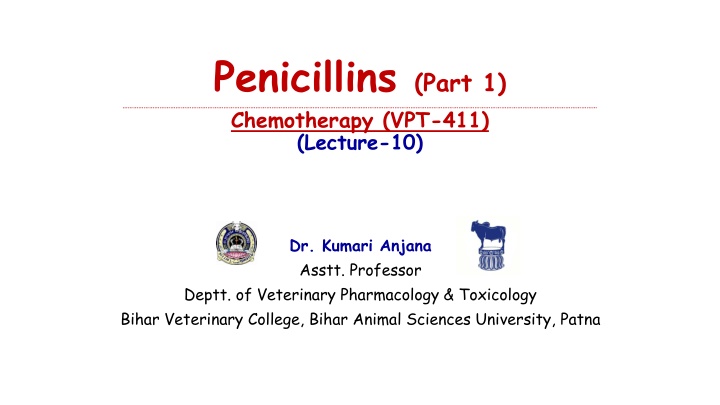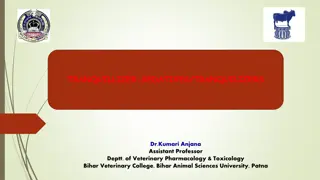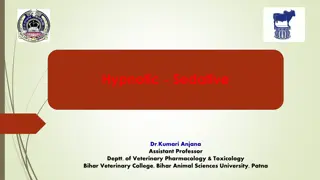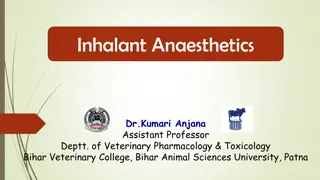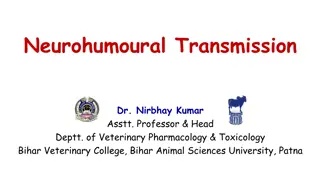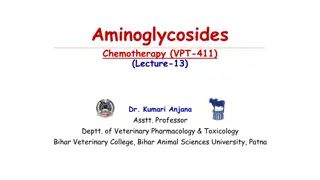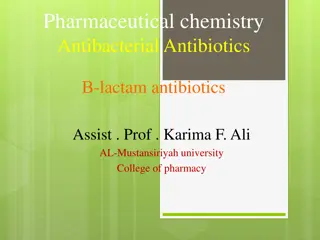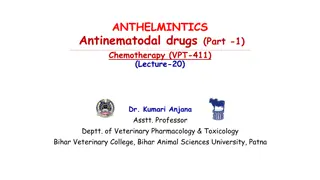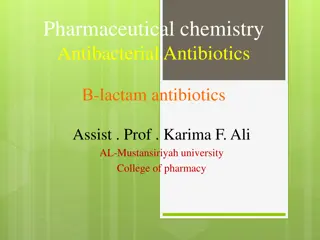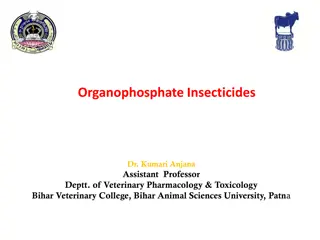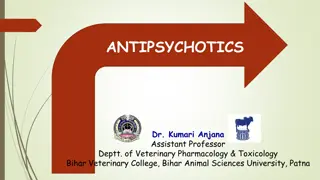History and Use of Penicillins in Veterinary Pharmacology
Penicillins, the first beta-lactam drugs discovered by Alexander Fleming, play a crucial role in combating bacterial infections. With a rich history dating back to 1928, these antibiotics revolutionized healthcare during World War II, significantly reducing mortality rates from infectious diseases. The discovery, development, and diverse applications of penicillins in veterinary pharmacology are explored in-depth, shedding light on their mechanism of action, classification, and clinical significance.
Download Presentation

Please find below an Image/Link to download the presentation.
The content on the website is provided AS IS for your information and personal use only. It may not be sold, licensed, or shared on other websites without obtaining consent from the author.If you encounter any issues during the download, it is possible that the publisher has removed the file from their server.
You are allowed to download the files provided on this website for personal or commercial use, subject to the condition that they are used lawfully. All files are the property of their respective owners.
The content on the website is provided AS IS for your information and personal use only. It may not be sold, licensed, or shared on other websites without obtaining consent from the author.
E N D
Presentation Transcript
Penicillins (Part 1) Chemotherapy (VPT-411) (Lecture-10) Dr. Kumari Anjana Asstt. Professor Deptt. of Veterinary Pharmacology & Toxicology Bihar Veterinary College, Bihar Animal Sciences University, Patna
Content of the chapter Beta-Lactam Antibiotics Penicillins Introduction, Hitory chemistry, classification spectrum MOA of Penicillins
Beta-Lactam Antibiotics Beta-lactam antibiotics constitute one of the most commonly prescribed drug classes with numerous clinical indications. These antibiotics have a beta-lactam ring as the essential antibacterial component in their chemical structure. The antibiotics under this group consist of: Penicillins, Cephalosporins, Cephamycins, Monobactams and Carbapenems.
Penicillins The penicillins are a large group of naturally occurring and semi-synthetic antibiotics. It was discovered by Sir Alexander Fleming in the filtrate of culture medium of mold Penicillium notatum Staphylococcal in 1929. having bacterial action on P. Chrysogenum, a mutant of P. notatum is presently used for commercial production of the antibiotic. Penicillin was the first antibiotic to be used clinically in 1941.
Discovery of Penicillin (First beta- lactam drug) Penicillin is the first natural antibiotic discovered by Alexander Fleming in 1928. While working in his lab, trying to kill a deadly bacteria, he noticed a blue mold growing on the dish. Noticed that the bacteria around the mold was dissolving. Learned that it was the mold Penicillum Notatum. Alexander Fleming; Source : Google image Penicillin is found in this mold.
For 9 years, nobody could purify the Penicillum Notatum to get the pure penicillin. Finally, in 1938, a team of Oxford University Scientists, headed by Howard Florey and Ernst B. Chain helped to develop penicillin. Ernst B. Chain Howard Florey Source : Google image
Penicillins role in WWII gave it a miracle drug reputation that led to its ubiquitous use. In the war, penicillin proved its mettle. Throughout history, the major killer in wars had been infection rather than battle injuries. In World War I, the death rate from bacterial pneumonia was 18 percent; in World War II, it fell, to less than 1 percent. Source : Google image
Chemistry The basic structure of penicillin comprises of a thiazolidine ring (A) connected to a beta-lactam ring (B), to which a side chain (R) is attached through an amide linkage. The side chain of natural penicillin can be split off by amidase to produce 6-aminopenicillanic (weak antibacterial activity). acid The enzyme breaks the beta-lactam ring (BL) and inactivates penicillin through formation of penicilloic acid, which does not possess antibacterial activity. Source: Essential of Vety. Pharmacology and Therapeutics
The natural penicillin is known as benzylpenicillin or Penicillin G and it is thermolabile and acid labile. Penicillin salts are formed by replacing H with Na and K from the carboxyl group attached to the thiazolidine ring. These salts are highly soluble and more stable than the parent acid. They are stable in dry state, but deteriorate rapidly at room temperature. Therefore, penicillin G solutions are always prepared freshly. The semisynthetic penicillin s have been developed by adding different side chains to it, with unique antibacterial activity and variable pharmacokinetic properties. The bacteria, which elaborate the enzyme penicillinase, a beta-lactamase, are resistant to penicillins.
Antibacterial spectrum Benzylpenicillin has narrow spectrum activity; effective against Gram positive organisms especially against cocci, but not against Gram negative organisms, except, a few. In general, viruses, fungi, rickettsiae, Chlamydia, acid fast bacilli and majority of Gram negative bacteria are insensitive to penicillin G. It is bactericidal at 0.5 U/ml concentration. Its action is unaltered by blood, pus or tissue breakdown products. The extended spectrum penicillins are active against both Gram positive and Gram negative organisms.
Classification of penicillins 1. Natural penicillins Penicillin G Repository Penicillins or Sparingly soluble organic salts of penicillin G: Procain penicillin G Benzathine penicillin G 2. Semisynthetic penicillin: a) Acid-stable penicillin s i) Phenoxymethyl penicillin (penicillin v) ii) Phenoxyethyl penicillin (Phenethicillin) b) Penicillinase-resistant penicillins : Acid labile penicillins: Methicillin, nafcillin Acid resistant penicillins: (Oxacillin, cloxacillin, dicloxacillin, flucoxacillin) 3. Extended spectrum penicillins: These are not Penicillinase-resistant. Amino penicillins: Ampicillin, amoxicillin, and hetacillin Carboxypenicillin: Carbenicillin and ticarcillin Ureidopenicillins : Azlocillin, Mezlocillin, and Piperacillin
Mechanism of action Mechanism of action All -lactam antibiotics interfere with the synthesis of bacterial cell wall. The bacteria synthesize UDP-N-acetylmuramic acid pentapeptide, called park nucleotide and UDP-N-acetyl glucosamine. The peptidoglycan residues are linked together forming long strands and UDP is split off. The final step is cleavage of the terminal D-alanine of the peptide chains by transpeptidases; the energy so released is utilized for establishment of cross linkages between peptide chains of the neighboring strands. This cross linking provides stability and rigidity to the cell wall. The -lactam antibiotics inhibit the transpeptidases so that cross linking does not take place. Source: Essential of Medical Pharmacology
When susceptible bacteria divide in the presence of a -lactam antibiotic- cell wall deficient (CWD) forms are produced. Because the interior of the bacterium is hyperosmotic, the CWD forms swell and burst bacterial lysis. This is how -lactam antibiotics exert bactericidal action. Under certain conditions and in case of certain organisms, bizarre shaped or filamentous forms, which are incapable of multiplying, result. Grown in hyperosmotic medium, globular giant forms or protoplasts are produced. Lytic effect of these antibiotics may also be due to depression of some bacterial autolysins which normally function during cell division.
Salient features related with MOA Penicillin binding proteins These enzymes and related proteins constitute the penicillin binding proteins (PBPs) which have been located in the membrane. bacterial cell Each organism has several PBPs and PBPs species differ in their affinity towards different antibiotics. obtained from different -lactam This fact probably explains their differing sensitivity to the various -lactam antibiotics.
Rapid cell wall synthesis occurs the organisms are actively multiplying; - lactam antibiotics are more lethal in this phase. The peptidoglycan cell wall is unique to bacteria. No such substance is synthesized (particularly, D-alanine is not utilized) by higher animals. This is why penicillin is practically nontoxic to man and animals. Ampicillin can penetrate Gram negative bacterial cell wall. Blood, pus, and tissue fluids do not interfere with the antibacterial action of -lactam antibiotics. The hypersensitive reaction of penicillin- the degradation products of penicillin which combine with host protein to act as hapten and become antigenic.
Cell wall of Gram positive bacteria and Gram negative bacteria Penicillin G is ineffective against Gram negative bacteria penetrate their cell wall which contains an extra lipopolysaccharide layer. as it cannot In gram-positive bacteria, the cell wall is almost entirely peptidoglycan, which is >50 layers thick and extensively cross linked, so that it may be regarded as a single giant mucopeptide molecule. made of Source : Google image In gram-negative bacteria, it consists of alternating layers of lipoprotein and peptidoglycan (each layer 1-2 molecule thick with little cross linking).
Summary Penicillin discovered by Sir Alexander Fleming. Alexander Fleming, Ernst B. Chain and Howard Florey Awarded Nobel Prize. All -lactam antibiotics interfere with the synthesis of bacterial cell wall.
